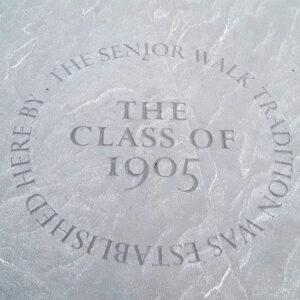calsfoundation@cals.org
University of Arkansas Senior Walk
The Senior Walk at the University of Arkansas (UA) in Fayetteville (Washington County) is one of the oldest and most distinctive traditions maintained by the university. The walk, which contains the inscribed names of over 200,000 seniors and graduates, snakes through the campus for several miles and includes the names of famous athletes, architects, poets, heads of state, a Miss America, and some honorary names including Bill and Hillary Clinton. The university claims it to be the only one of its kind in the United States.
It is believed that the origin of the walk lies in a request by the Class of 1905 to inscribe the names of class members on a campus sidewalk. Once permission was given, the names were hand inscribed by a student; apparently, the first name inscribed was Bertha Abercrobie. Within a few years, interest in the walk grew, with the Class of 1904 becoming the second class to be included. Additional classes were slowly added, permanently establishing the annual tradition.
Through 1924, all names were hand inscribed, but in 1925 a raised-letter stamp began to be used to impress the names into the concrete. That same year, it was decided that the walk would list graduates only, not all members of the senior class. In 1930, a major addition was made to the walk when the names of class members from 1876 through 1903 were added to the walk in front of Old Main.
Over time, the number of names of yearly graduates to be inscribed grew so large that the time required to inscribe the names became an issue. In 1986, the university’s Facilities Management invented a device it named the “Sand Hog.” The device is used to sandblast the names directly into the hardened concrete, making the process faster and more efficient. Names are routinely inscribed in the spring, the year following graduation.
By the early part of the twenty-first century, the walk was beginning to show signs of age. Many areas had cracked, with some sections, like the ones for 1906 and 1907, almost illegible. By that time, one section from 1905 had been replaced due to deterioration. In 2013, the school began documentation of the walk’s condition and, a year later, conducted a complete assessment. It was determined that the first fifty years of the walk were in need of replacement at a cost of approximately half a million dollars. The funds necessary for the restoration were acquired from private donations and a grant from the Arkansas Natural and Cultural Resources Council. The restoration used high-grade reinforced monumental concrete, with each class now being identified by a bronze year. Plans are underway to determine a proper method to display some of the class blocks removed during restoration. The plaza at the entrance of Old Main was restored, at a cost of $650,000, at the same time of the walk restoration. Both restorations were completed by fall of 2020.
In the 1970s and 1980s, there was a fee to have one’s name inscribed, but that fee was later removed. However, students can choose to not have their name included. Each name inscription is limited to twenty-two characters plus degree. Once the information has been inscribed, no changes can be made unless there was an administrative error.
Some interesting facts and lore surround the senior walk. There was no recognition for the Classes of 1887 and 1895, as a change in the school calendar in those years resulted in no graduates. A supposed curse is associated with the Class of 1900, as some accounts state that the students began to consider the class block unlucky when it cracked. According to tradition, students who walk on that class inscription are doomed not to graduate. The idea of the curse stems from a false story stating that all class members died on a senior trip.
With the increasing number of graduates each year, the space needed for the walk became limited, causing the university to begin negotiating with private landowners just off campus for the placement of future graduates’ names.
For additional information:
Bartholomew, Dustin. “Senior Walk among Longest, Most Unique Traditions at University of Arkansas.” Fayetteville Flyer. https://www.fayettevilleflyer.com/2015/08/18/senior-walk-among-longest-most-unique-traditions-at-university-of-arkansas/ (accessed April 14, 2021).
Bowen, Bill. “UA’s Senior Walk Back up, Running.” Arkansas Democrat-Gazette, November 2, 2020, pp. 1B, 3B.
“If This Walk Could Talk: Reflections on 150 Years.” https://vimeo.com/674991990?ref=em-share&fbclid=IwAR2tIFPMP_mb8mSObX7VHoGDBjMST6pnOPp1yXZZoGyqI43MskesvWh6YS4 (accessed February 11, 2022).
Leflar, Robert Allen. The First 100 Years: Centennial History of the University of Arkansas. Fayetteville: University of Arkansas Press, 1972.
Mike Polston
CALS Encyclopedia of Arkansas
 Early Twentieth Century, 1901 through 1940
Early Twentieth Century, 1901 through 1940 Education, Higher
Education, Higher Historic Preservation
Historic Preservation Senior Walk Engraving
Senior Walk Engraving  Senior Walk Names
Senior Walk Names  Senior Walk Plaque
Senior Walk Plaque  Senior Walk, 1876 Step
Senior Walk, 1876 Step 




Comments
No comments on this entry yet.